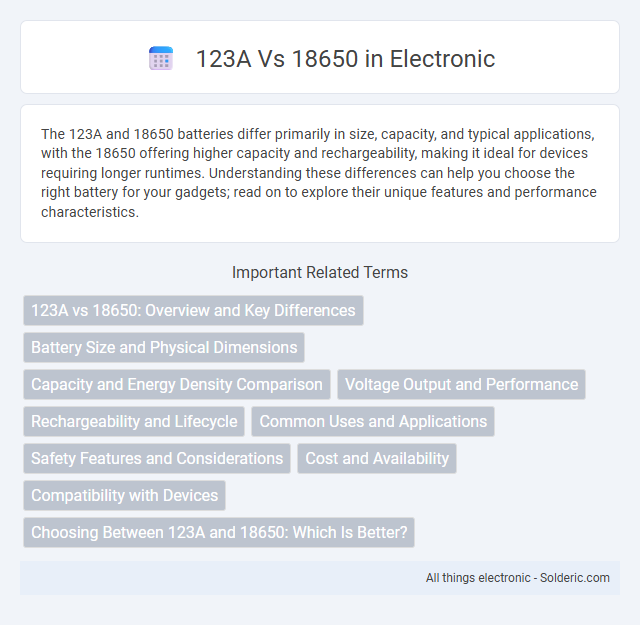The 123A and 18650 batteries differ primarily in size, capacity, and typical applications, with the 18650 offering higher capacity and rechargeability, making it ideal for devices requiring longer runtimes. Understanding these differences can help you choose the right battery for your gadgets; read on to explore their unique features and performance characteristics.
Comparison Table
| Feature | 123A Battery | 18650 Battery |
|---|---|---|
| Size (Diameter x Length) | 17mm x 34.5mm | 18mm x 65mm |
| Battery Type | Lithium Primary (Non-Rechargeable) | Lithium-ion Rechargeable |
| Voltage | 3V | 3.6V - 3.7V |
| Capacity | Approximately 1500mAh | Typically 2000mAh to 3500mAh |
| Rechargeability | No | Yes |
| Common Uses | High-drain cameras, flashlights, security devices | Laptops, electric vehicles, flashlights, power tools |
| Weight | About 17g | Approximately 45g |
| Cost | Lower per battery, non-rechargeable | Higher initial cost, rechargeable |
| Environmental Impact | Disposable, less eco-friendly | Rechargeable, more sustainable |
123A vs 18650: Overview and Key Differences
123A batteries are compact, lithium primary cells commonly used in small electronics and offer a nominal voltage of 3 volts, whereas 18650 batteries are larger, rechargeable lithium-ion cells with a typical voltage of 3.6 to 3.7 volts. The energy capacity of 18650 batteries ranges from 1800mAh to 3500mAh, significantly surpassing the 1500mAh capacity of 123A cells, making 18650s ideal for high-drain devices and extended use. Your choice between 123A and 18650 depends on the device's size, power requirements, and whether rechargeability is a priority.
Battery Size and Physical Dimensions
The 123A battery typically measures 34.5mm in length and 17mm in diameter, making it shorter and slightly wider compared to the 18650 battery, which is approximately 65mm long and 18mm in diameter. These size differences affect device compatibility, with 123A commonly used in smaller electronics and 18650 favored for larger, high-capacity applications. The compact size of the 123A contrasts with the cylindrical form factor and higher energy density of the 18650 cells.
Capacity and Energy Density Comparison
The 18650 battery typically offers a higher capacity, ranging from 1800mAh to 3500mAh, compared to the 123A battery's 1500mAh to 1700mAh, making 18650 a better choice for longer-lasting power. Energy density in 18650 cells is significantly greater, approximately 250-270 Wh/kg, while 123A batteries usually provide around 140-160 Wh/kg, reflecting more efficient energy storage per weight. This capacity and energy density advantage enables 18650 batteries to power high-drain devices more effectively than 123A batteries.
Voltage Output and Performance
The 123A battery typically outputs 3 volts, offering higher voltage suitable for specific high-drain devices, while the 18650 battery delivers 3.6 to 3.7 volts, providing more consistent power and longer runtime in applications like laptops and flashlights. In terms of performance, 18650 batteries generally have higher capacity, ranging from 1800mAh to 3500mAh, compared to the 600mAh capacity of 123A cells, which affects how long your device operates between charges or replacements. Choosing between 123A and 18650 batteries depends on your device's voltage requirements and desired operational duration.
Rechargeability and Lifecycle
The 18650 battery offers superior rechargeability and a longer lifecycle compared to the 123A, which is typically a single-use lithium battery. You can expect the 18650 to handle hundreds of charging cycles, making it ideal for high-drain devices and frequent use. In contrast, 123A batteries provide strong initial power but lack the ability to be recharged, resulting in a shorter overall lifespan.
Common Uses and Applications
The 123A battery is commonly used in high-drain devices like cameras, flashlights, and smoke detectors due to its compact size and high energy density. The 18650 battery is prevalent in rechargeable applications such as laptop battery packs, electric vehicles, and portable power tools because of its larger capacity and rechargeability. Understanding the specific voltage, capacity, and size differences helps select the right battery for devices requiring either disposable or rechargeable power sources.
Safety Features and Considerations
123A batteries typically incorporate built-in safety vents and overcurrent protection to prevent overheating and explosions, making them safer for high-drain devices. In contrast, 18650 lithium-ion cells often require external protection circuits to manage risks such as overcharging, short circuits, and thermal runaway. Proper handling and using protected 18650 cells significantly enhance safety, while 123A batteries offer more inherent safety due to their sealed design and chemistry.
Cost and Availability
123A batteries generally cost more per unit than 18650 batteries due to their specialized use in high-drain devices like cameras and tactical equipment. 18650 batteries are widely available and more affordable, benefiting from mass production for applications such as laptops, power tools, and electric vehicles. The extensive market presence of 18650 cells ensures better availability and a broader range of purchasing options compared to 123A batteries.
Compatibility with Devices
123A batteries and 18650 batteries differ significantly in compatibility with devices due to their size and voltage specifications. 123A batteries are typically smaller, cylindrical cells often used in cameras, flashlights, and security devices, while 18650 batteries are larger, rechargeable lithium-ion cells commonly found in laptops, high-performance flashlights, and electric vehicles. Ensuring compatibility means verifying your device's battery compartment size and voltage requirements, as attempting to interchange these batteries without proper fit and electrical matching can lead to device malfunction or damage.
Choosing Between 123A and 18650: Which Is Better?
Choosing between 123A and 18650 batteries depends on your device's power requirements and usage duration. 123A batteries are compact, offer high voltage (3V), and are ideal for low-drain devices like cameras and alarms, while 18650 batteries provide higher capacity (typically 2600-3500mAh) and are rechargeable, making them better for high-drain applications such as flashlights and laptops. Understanding your device's voltage and energy needs helps you select the optimal battery type to maximize performance and battery life.
123A vs 18650 Infographic

 solderic.com
solderic.com